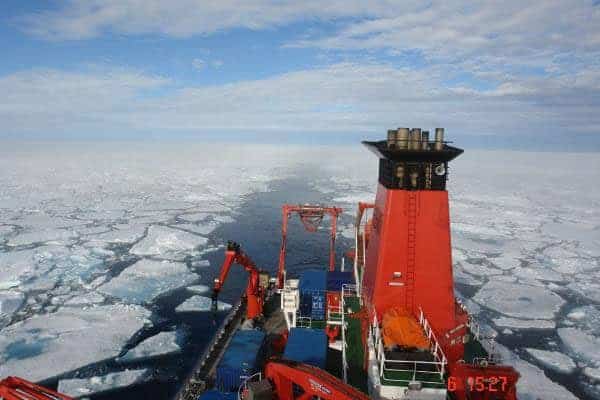
A stretch of water east of Greenland, considered to be the Arctic’s main source of heat from the North Atlantic, is warmer now than it has been in at least 2000 years. That is the claim of researchers in Europe and the US who suggest further warming will amplify the effects of climate change in the Arctic region.
The new study considers water temperatures in the Fram Strait, a passage of seawater between Greenland and the Svalbard archipelago. Climate scientists have identified that conditions in this stretch of water will play a key role in determining whether the Arctic ice cap will survive future summers.
“Cold seawater is critical for the formation of sea ice, which helps to cool the planet by reflecting sunlight back to space,” says Thomas Marchitto, one of the researchers, based at the University of Colorado in the US. “Warmer waters could lead to major sea ice loss and drastic changes for the Arctic.”
Recent warming
Marchitto’s group has determined seawater temperatures in this zone for the past 2000 years. And the finding is that – having remained relatively stable until around 1850 – the average summer seawater temperatures have increased by around 2 °C since that time.
The warming signal being detected further bears out the growing body of evidence that Polar regions are in the frontline when it comes to feeling the effects of global climate change Robert Murray, Heriot-Watt University
Given that meteorological and oceanographic data from this region only dates back 150 years, the researchers had to reconstruct historic temperatures, which they did using the sediment record. They catalogued over 900 different species of the micro-organism foraminifera, assigning an age from the depth of sediments. Because different species of this organism exist at specific temperatures, they were able to build a comprehensive picture of past sea temperatures.
To confirm the data, the researchers applied a second dating method by documenting the magnesium–calcium ratio in the calcite shells of foraminifers, which directly correlates with temperature variability. “The methods we have applied for our records are well established and have been found to give very reliable results in many different ocean basins,” says Robert Spielhagen, another member of the group, based at the Academy of Sciences, Humanities and Literature, in Mainz, Germany.
Arctic amplification
Murray Roberts, a bioscientist at Heriot-Watt University in Scotland, who was not involved in the research, sees the findings as further evidence of the Arctic’s susceptibility. “The warming signal being detected further bears out the growing body of evidence that Polar regions are in the frontline when it comes to feeling the effects of global climate change.” Roberts does note, however, that the resolution of sediments used in the study is limited by the mixing of seawater and sediments.
Despite its modest size, the Fram Strait has an elevated role in the Arctic climate because it is its main source of heat from the ocean, and many scientists believe the Arctic is particularly vulnerable to climate change. Arctic temperatures near the land surface, for instance, have been nearly twice the global average in recent decades because of this “Arctic amplification”.
James Alexander Screen, an ocean scientist at the University of Melbourne, Australia, agrees that the Fram Strait will play a key role in deciding the fate of Arctic sea ice and he speculates about the effects on the local ecology. “Many aquatic plants like algae and plankton, and crustaceans and fish species are sensitive to water temperature and/or the presence of sea ice,” he says. Adding, “In turn, larger predators that feed on these organisms are sensitive to their distribution and abundance.”
Wider changes
Whether these circulation changes in the atmosphere and ocean are linked to human-induced global warming, we do not know Rune Rand Graversen, Stockholm University
Rune Rand Graversen, a meteorologist at Stockholm University, Sweden, believes that the dynamics of Arctic sea ice is also strongly intertwined with changes in atmospheric circulation. “[Atmospheric changes] may bring warm and humid air to Arctic Ocean areas that are vulnerable to become fast ice free. And they may cause increased ice export from the Arctic by changing winds” he says. “Whether these circulation changes in the atmosphere and ocean are linked to human-induced global warming, we do not know”.
While the researchers assert that it is difficult to relate local trends to wider ocean circulation, they acknowledge that it could be due to warming at lower latitudes, particularly in the Gulf Stream. “Generally speaking, the warm Atlantic water in the Fram Strait represents the northward extension of the Gulf Stream system. This system attains its heat in low subtropical latitudes,” says Spielhagen.
This latest study comes hot on the heels of a separate study published in Proceedings of the National Academy of Sciences, reported on physicsworld.com, which identified warming in the West Atlantic. The researchers in that case found that warming in the West Atlantic has caused the Gulf Stream off the coast of Canada to drift northwards from its historic position in recent years.
The researchers will now develop their research by trying to reconstruct temperatures in the Fram Strait for times when the total solar energy reaching the Earth’s surface was higher. One example is the time after the last ice age at about 9–10,000 years ago when solar energy influx was approximately 10% higher than it is today.
The findings are described in Science.



